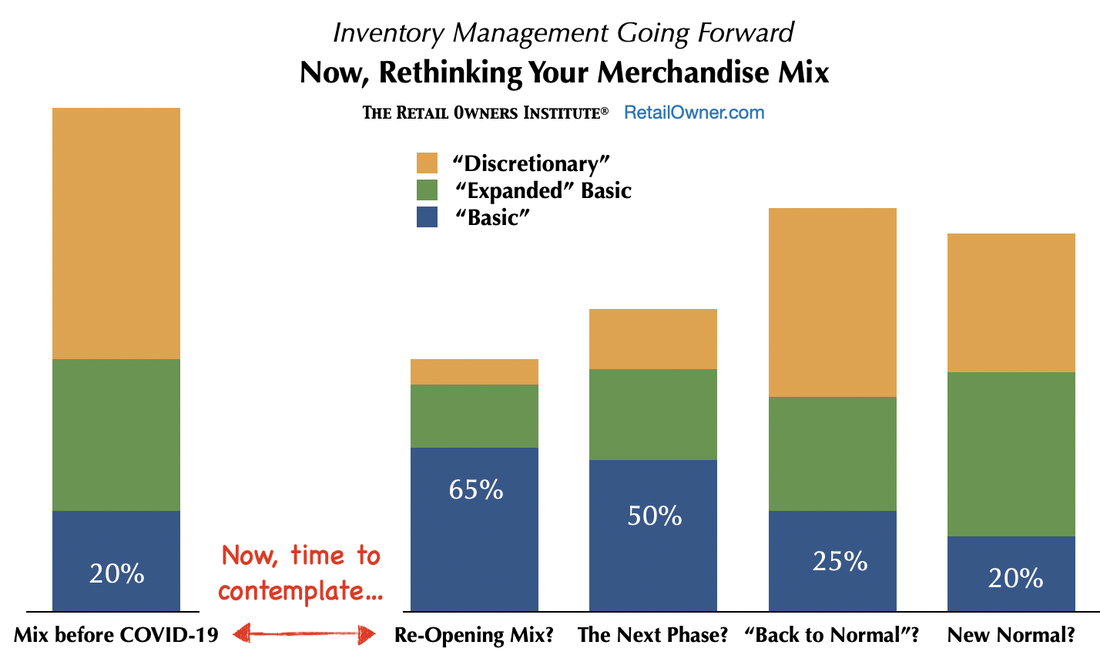The Retail Owners Institute® has developed a retail strategy for "Inventory Management Going Forward."
As we often do, it was recapped as an unassuming chart (see below) identifying the Five Stages of Merchandise Mix Management, from "Before COVID-19" to the "New Normal?"
As we often do, it was recapped as an unassuming chart (see below) identifying the Five Stages of Merchandise Mix Management, from "Before COVID-19" to the "New Normal?"
Total Inventory Levels
We assume that consumer discretionary spending will plummet initially, and be slow to recover.
Merchandise Mix
We assume that not only is consumer spending likely to be tentative, spending on discretionary items will be impacted the most, especially initially.
WHAT DOES OUR GOING FORWARD CHART CAPTURE?
A strategic retail framework. A point of reference, a template for your own inventory strategy going forward.
Where to Start
First, during this interval of "Contemplative Time," make your own "Going Forward" charts.
Remember, no specific numbers, no definite timetables. Just Big Picture ideas: What might your merchandise mix look like at each of these five stages?
Here is where your work with The ROI's 3-in-1 Cash Flow Calculator is really helpful. (go here for special free access during these times)
Given your "best guesstimate" entries for monthly sales and margins, the 3-in-1 Cash Flow Calculator can tell you how MUCH inventory (total) to have, based on sales expectations.
And by the way, it also shows you what that means about cash!
Free • 3-in-1 CASH FLOW Calculator
NOW, BACK TO FOCUS ON THE MIX
Just what IS “basic” merchandise or the "never-outs" for your store?
Just to teach the concept: take an apparel store that has been selling lots of blouses. One particular style is available from the vendor in six colors, all of which the store has heretofore carried.
We know this is not an easy project. Very time consuming. We're sorry, but it is essential.
BACK TO THE 3-IN-1 CALCULATOR
Impact on margins
True, reliance on more basics and “expanded basics” versus the discretionary items means that margins are likely to be lower during these initial recovery phases.
TAKE THAT, UNCERTAINTY!
Well, there you have it. A plan you can have confidence in. And that is the very best way to deal with that fog of uncertainty!
How great is that?! Have fun!
We assume that consumer discretionary spending will plummet initially, and be slow to recover.
- Therefore, total inventory for Re-Opening must be significantly reduced from "Before COVID-19" levels.
- Over time, as sales increase, inventory levels would rise. (Although patience must still be shown.)
Merchandise Mix
We assume that not only is consumer spending likely to be tentative, spending on discretionary items will be impacted the most, especially initially.
- The relative merchandise mix – eg, the basics, “never-outs” – changes from perhaps 20% “before COVID-19” to 65% for Re-Opening.
- Increasing inventory amounts over time would come from additions to "expanded basics" and, lastly, if ever, discretionary items.
- Therefore, the percentage of never-out merchandise could decline over time.
WHAT DOES OUR GOING FORWARD CHART CAPTURE?
A strategic retail framework. A point of reference, a template for your own inventory strategy going forward.
Where to Start
First, during this interval of "Contemplative Time," make your own "Going Forward" charts.
Remember, no specific numbers, no definite timetables. Just Big Picture ideas: What might your merchandise mix look like at each of these five stages?
Here is where your work with The ROI's 3-in-1 Cash Flow Calculator is really helpful. (go here for special free access during these times)
Given your "best guesstimate" entries for monthly sales and margins, the 3-in-1 Cash Flow Calculator can tell you how MUCH inventory (total) to have, based on sales expectations.
And by the way, it also shows you what that means about cash!
Free • 3-in-1 CASH FLOW Calculator
NOW, BACK TO FOCUS ON THE MIX
Just what IS “basic” merchandise or the "never-outs" for your store?
Just to teach the concept: take an apparel store that has been selling lots of blouses. One particular style is available from the vendor in six colors, all of which the store has heretofore carried.
- Two colors, such as white and ivory, might be considered "Basic," especially in the heart sizes.
- Navy and brown might be considered "Expanded Basics," while the first two colors become available in more sizes.
- Finally, lilac and powder blue would be considered very optional, what we refer to as "Discretionary."
We know this is not an easy project. Very time consuming. We're sorry, but it is essential.
BACK TO THE 3-IN-1 CALCULATOR
Impact on margins
True, reliance on more basics and “expanded basics” versus the discretionary items means that margins are likely to be lower during these initial recovery phases.
- But remember, turns could go up.
- Make that change on the Inventory tab of the 3-in-1 Calculator.
- Now go to the Cash tab. What could that mean for your cash flow? (See? The power of GMROI!!!)
TAKE THAT, UNCERTAINTY!
Well, there you have it. A plan you can have confidence in. And that is the very best way to deal with that fog of uncertainty!
- This will be your plan. You will know how the steps you are taking now fit into the Big Picture of where you want to end up.
- And, you will know the potential financial outcomes of this plan, including your likely cash flow.
- Reduce inventory by a targeted amount (eBay? Your own e-commerce? Other outlets?)
- Reduce the “right” inventory (eg, the discretionary items), so you are best positioned for the Re-Opening Phase
- How will you source the new mix of merchandise?
- How will you showcase it in your store?
- How best to let your customers know about it?
How great is that?! Have fun!

